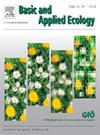Unravelling the multi-scale structure of vertebrate scavenger communities: The role of beta-diversity in livestock carcass consumption
IF 3.5
2区 环境科学与生态学
Q2 ECOLOGY
引用次数: 0
Abstract
Understanding the structure of communities across multiple scales is useful for predicting impacts on biodiversity and ecosystem functioning. Scavenging, an important ecological function performed by scavenger assemblages, stands as a significant force shaping ecosystems. Using biodiversity partitioning, we assess the relative contribution of multiple scales (i.e., within and among individual carcasses, species and habitats) to the richness and Shannon diversity of vertebrate scavenger communities consuming anthropogenic food subsidies (i.e. livestock carrion) in central Argentina. We further evaluate the potential effect of carcass and habitat characteristics (including human impact) on the richness, abundance and diversity of vertebrate scavengers. A total of 31 carcasses, 22 of cow and nine of sheep, were monitored using remote cameras in cropland and natural habitats, recording consumption by 10 vertebrate species (four birds and six mammals). 50 % of scavenger species were observed at carcass level (α1 = 4.94 species), a contribution lower than expected by chance. While the turnover of species among carcasses (β1 diversity) significantly contributed (40 %) to regional richness (γ diversity), turnover of species between carrion types and habitats (β2 diversity) contributed a smaller fraction (10 %). Partitioning of Shannon diversity showed similar patterns to richness. Scavenger abundance increased during spring and was positively influenced by carcass weight; furthermore, carcasses in croplands supported less abundance that those located in natural habitats. Aligning with the theory of carrion unpredictability in maintaining biodiversity, our results suggest that scavenger species replacement (turnover) at human-mediated carcasses scattered in the field plays a significant role in shaping vertebrate scavenger assemblages.
揭示脊椎动物食腐动物群落的多尺度结构:β -多样性在牲畜胴体消耗中的作用
了解多尺度的群落结构有助于预测对生物多样性和生态系统功能的影响。食腐是一种重要的生态功能,是形成生态系统的重要力量。利用生物多样性分区,我们评估了多个尺度(即个体尸体内部和之间、物种和栖息地)对阿根廷中部消耗人为食物补贴(即牲畜腐肉)的脊椎动物食腐动物群落丰富度和香农多样性的相对贡献。我们进一步评估了腐食动物胴体和栖息地特征(包括人类影响)对丰富度、丰度和多样性的潜在影响。在农田和自然栖息地使用远程摄像机对31具尸体(22头牛和9头羊)进行了监测,记录了10种脊椎动物(4种鸟类和6种哺乳动物)的消耗情况。50%的清道夫物种出现在胴体水平(α1 = 4.94种),其贡献低于偶然预期。腐尸间物种转换(β1多样性)对区域丰富度(γ多样性)贡献显著(40%),而腐尸类型和生境间物种转换(β2多样性)对区域丰富度(γ多样性)贡献较小(10%)。Shannon多样性的分配模式与丰富度相似。春季食腐动物丰度增加,且受胴体重的影响;此外,农田里的尸体比自然栖息地里的少。与腐肉在维持生物多样性中的不可预测性理论一致,我们的研究结果表明,分散在野外的人类介导的腐肉物种替换(更替)在形成脊椎动物腐肉组合中起着重要作用。
本文章由计算机程序翻译,如有差异,请以英文原文为准。
求助全文
约1分钟内获得全文
求助全文
来源期刊

Basic and Applied Ecology
环境科学-生态学
CiteScore
6.90
自引率
5.30%
发文量
103
审稿时长
10.6 weeks
期刊介绍:
Basic and Applied Ecology provides a forum in which significant advances and ideas can be rapidly communicated to a wide audience. Basic and Applied Ecology publishes original contributions, perspectives and reviews from all areas of basic and applied ecology. Ecologists from all countries are invited to publish ecological research of international interest in its pages. There is no bias with regard to taxon or geographical area.
 求助内容:
求助内容: 应助结果提醒方式:
应助结果提醒方式:


